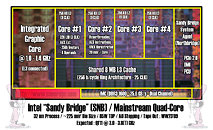Monday, July 6th 2009

Intel SandyBridge Mainstream Quad-Core CPU Architecture Surfaces
Intel is on a golden path, showing no signs of a slowdown as far as technology development is concerned. After having pushed its 32 nm manufacturing node and its derived Westmere architecture to production grade, Intel seems to have already made a prototype on the 32 nm node, which will serve a technology leap on 32 nm. The company uses a "tick-tock" model of process development, where each processor architecture gets to be made in two manufacturing processes, while each process gets to build two succeeding architectures. The current Nehalem architecture meets 32 nm with the Westmere architecture, while the 32 nm node meets its next architecture with the SandyBridge.
SandyBridge is characterised by a larger level of integration of components. While Nehalem and Westmere "Lynnfield" and "Clarksfield" mainstream processors use a multi-chip module that holds the CPU and north-bridge dice, SandyBridge will see an integration of both into a monolithic, rectangular die spreading across an area of around 225 sq. mm. Significant portions of the die will be occupied with a DirectX 11-compliant integrated graphics processor, the "SandyBridge System Agent" (a component which includes a PCI-Express hub, and DMI. The L3 cache is the largest component on the die. It will have a large 256-bit ring-topology, which lets it not only perform cache operations, but also as a fast transport medium between the various components.
There are four x86-64 processing cores with their own 256 KB L2 caches, and will feature the Advanced Vector eXtensions (AVX), the next generation SIMD instruction set. With so much packed, the chip will have a rated TDP of "only" 85W. When in production, it could come with clock speeds as high as 3.80 GHz. There is an indication that this chip will retain the LGA-1156 package to keep the upgrade path in progress. Interestingly, the chip is taped out in this quarter, while it will reach production-grade in the first quarter of 2011. Meanwhile LGA-1366 gets its next big thing with the Westmere-based Core i9 hexa-core processor.
Source:
CanardPC
SandyBridge is characterised by a larger level of integration of components. While Nehalem and Westmere "Lynnfield" and "Clarksfield" mainstream processors use a multi-chip module that holds the CPU and north-bridge dice, SandyBridge will see an integration of both into a monolithic, rectangular die spreading across an area of around 225 sq. mm. Significant portions of the die will be occupied with a DirectX 11-compliant integrated graphics processor, the "SandyBridge System Agent" (a component which includes a PCI-Express hub, and DMI. The L3 cache is the largest component on the die. It will have a large 256-bit ring-topology, which lets it not only perform cache operations, but also as a fast transport medium between the various components.
There are four x86-64 processing cores with their own 256 KB L2 caches, and will feature the Advanced Vector eXtensions (AVX), the next generation SIMD instruction set. With so much packed, the chip will have a rated TDP of "only" 85W. When in production, it could come with clock speeds as high as 3.80 GHz. There is an indication that this chip will retain the LGA-1156 package to keep the upgrade path in progress. Interestingly, the chip is taped out in this quarter, while it will reach production-grade in the first quarter of 2011. Meanwhile LGA-1366 gets its next big thing with the Westmere-based Core i9 hexa-core processor.

32 Comments on Intel SandyBridge Mainstream Quad-Core CPU Architecture Surfaces
How can this possibly not compete with i9 and indeed anything higher? It has a graphics card and a NB attached inside of it.
The integration of the graphics matched with laptops will be very effective for casual consumers. Can't wait to see how it pans out.
Also, since when is i9 an octo-core? Last I heard it was six.
But you can't deny that this is the future. It's a single chip that houses all the important parts of the motherboard control. Perhaps they wish to make the argument that integrated graphics inside a CPU cannot yet be high-end, but my point is that this is not a CPU.. it's something much more. This really came out of left field. I do not understand why i9 can't have a built-in NB-SB as well. Unless of course.. it scrapped those solely in order to have double the performance. That still seems crazy. But, if i9 really does have 8 cores, it's mine.
Actually, if they are offering this a whole year after i9 gets released, it's not even in competition with i9, rather with whatever comes afterwards.
It also situates the longevity of the current generation of sockets where 1156 will be here at least two years into the future. And.. it's nice to see there are no more Dual-core CPU's.
In a high end system (dedicated GPU detected), the architecture may be designed to use the integrated graphics as a extra FPU(s) meaning higher floating point performance. <-- Speculation.
nice.
Can't wait to see the performance for both the i9 and these sandybridge procs
At which point, I would like to give a shout-out to all the world's-best scientists working in Israel. :)
Also, I'M GOING TO HAVE TO WAIT 'TILL 2011 NOW?! GAAAAWD!
We have 4 cores that are pretty beefy, including the northbridge and a GPU :eek: Then we have 32kb L1 cache which is pretty standard and the 256kb present on core i7 and the 8mb L3 to make up for the lack of L2 cache but I don't think it will be enough compensation since the IGP is connected as well.
All this though on the 32nm process is quite impressive.
Move along people...
I think the first of the 32nm Westmere chips are coming out Q4 '09 or Q1 '10. If you're looking to buy, I wouldn't wait any longer than that. They should help alleviate the major heat issue seen in the 45nm Nehalems. Heat could be the number one reason why Intel is waiting to release more Core i# processors.In part, I agree. The only thing impressive is the monolithic design as Dr. Pepper was pointing out...
At this point, I'm confused as to what "it" is. Is it a P6 derivative or a NetBurst derivative? I expected it to be a P6 derivative--something the Israel branch has been working on since Penryn. The picture makes the claim it is a NetBurst derivative. I don't know what to expect anymore. :(
Ever since C2D came out three years ago, I've been hearing nothing but rants about the thermal envelope. They said 45nm would fix it, now they're saying that i7 has heat issues too. The reason Netburst overheated was exactly because of the shrinkage in die. The pipes were too small and they leaked. The tri-pipe design and indeed the architecture is what counts. CPU's are always going to have 'heat issues'.
I assume it is P6. That is only a sketch, as far as I know.. although Intel has been pretty accurate about releasing information for a long time.
Nehalem can hit 85C on the stock HSF (it starts cutting back speed/voltage at 100C). Core i5 and most likely, Core i3 will have more total transistors because of their MCM northbridge on-die (I think the northbridge is also 65nm rather than 45nm). This means that in order for Intel to make it all fit and still beat Core 2 Quad, they have to shrink the die.
I couldn't find any power specs on X58 chipset. I'd imagine it is lower than those from Core 2 just because it is one chip instead of two.
I mean, if the metal provided with the CPU was the problem, someone would have thought about it already.
The thing is.. it really doesn't matter any bit if you buy an after-market cooler. You will get to the same performance with said cooler. Be it because the chip has more transistors and thus higher performance in all, or because it is clocked higher.